
From Offices to Retail: Discover the Best Commercial Interior Design Styles
Commercial interior design is more than just aesthetics; it’s about creating functional, comfortable, and visually appealing spaces that serve a specific purpose. Whether you’re designing a bustling restaurant, a corporate office, or a retail store, the type of design you choose can influence not only how your business operates but also how customers and employees perceive it. In this guide, we’ll explore the various types of commercial interior design, looking at what each style entails and how it applies to businesses across industries. Plus, we’ll delve into some popular commercial spaces in California to provide real-world examples.
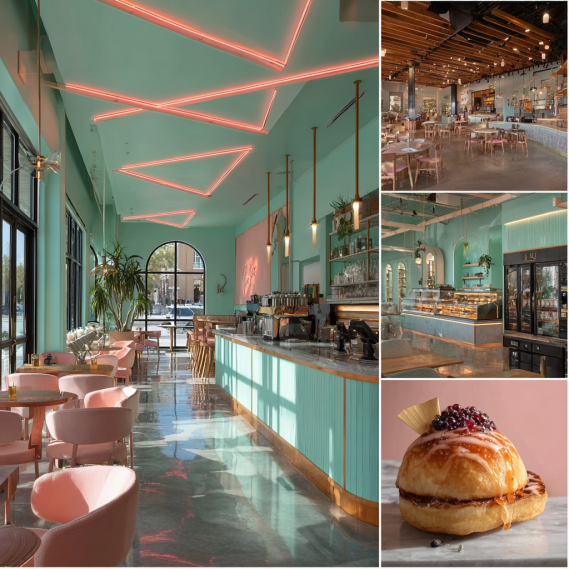
What is Commercial Interior Design?
Commercial interior design focuses on enhancing the functionality, aesthetics, and experience of spaces used for business purposes. These spaces are specifically designed to support the needs of both the business and its clients or employees.
- A well-designed office can improve employee performance by 15-30%.
- 75% of customers say the design of a store or restaurant influences their buying behavior.
Whether it’s a corporate office, retail space, or hospitality venue, commercial interior design aims to create a space that balances business needs with an engaging atmosphere.
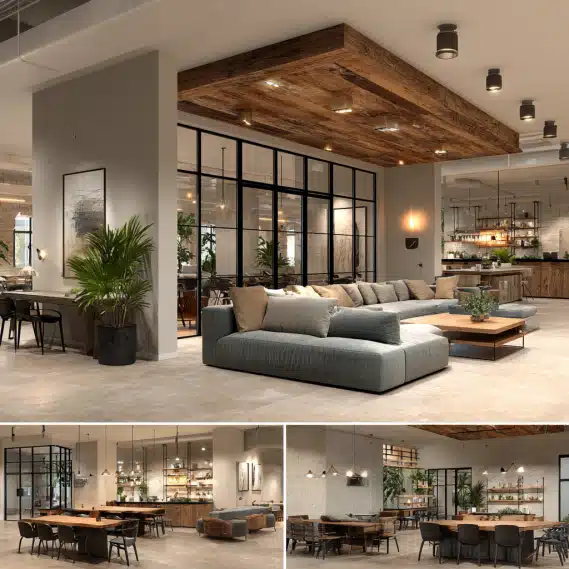
California Commercial Interior Design That Performs
From concept to handover, our commercial interior design turns space into ROI—code-ready, brand-right, and built to last across California.
Types of Commercial Interior Design
Understanding the different types of commercial interior design is essential for creating spaces that not only look great but also function effectively. From offices and retail spaces to hospitality and healthcare, each type of design serves a unique purpose. Let’s explore the most common commercial interior design styles and how they can elevate your business environment.
Office Interior Design
Office interior design is essential for creating a workspace that fosters productivity, collaboration, and well-being. The design can range from corporate and formal to more relaxed and creative, depending on the company culture and the tasks at hand.
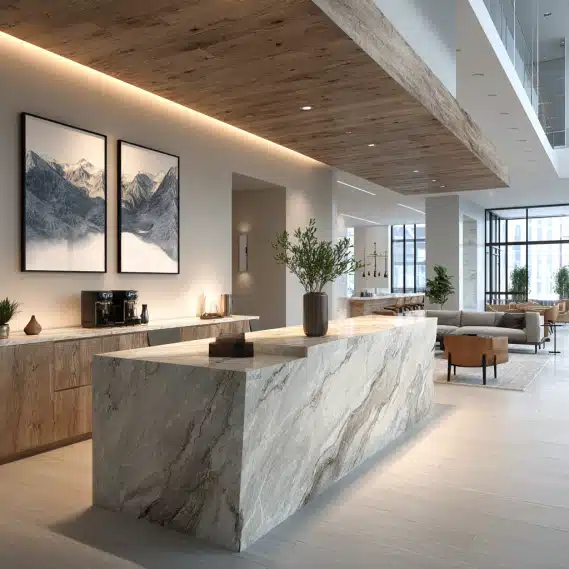
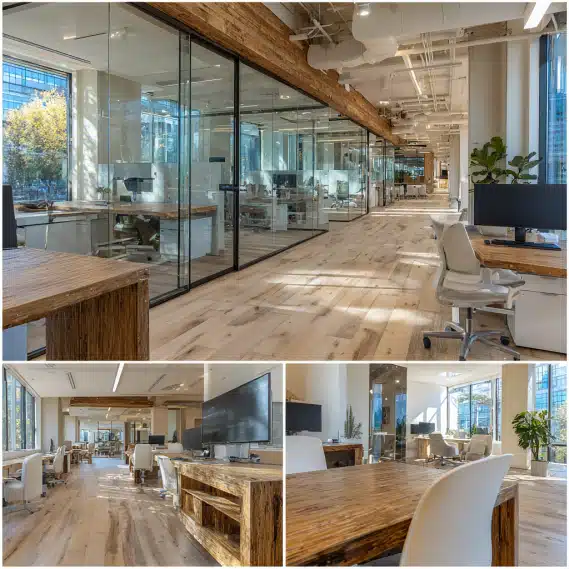
Popular Materials
- Sustainable Wood: Used in desks, shelving, and flooring, sustainable wood materials, such as bamboo or reclaimed timber, bring warmth, sustainability, and a modern aesthetic to office spaces.
- Glass Partitions: These provide a balance between openness and privacy, fostering transparency in the workplace while maintaining quiet spaces for individual focus. They’re ideal for offices that need to balance collaborative and private areas.
- Ergonomic Furniture: Chairs, desks, and accessories designed with ergonomics in mind support employee health by reducing strain and improving comfort. Features like adjustable heights and lumbar support are essential for long hours of work.
Key Design Elements:
- Open Spaces: By integrating open layouts, businesses encourage teamwork and free-flowing communication, fostering a collaborative environment. Studies show that employees in open office settings report 15% more satisfaction with their workplace interactions.
- Private Areas: While open spaces are important, well-designed offices also incorporate private zones for focused work. Quiet rooms and personal pods can boost concentration and help employees stay on task.
- Natural Lighting: Access to natural light has been proven to enhance employee well-being and productivity. 10% higher productivity and a 15% improvement in mood are common among employees who work in spaces with ample daylight, as natural light reduces stress and improves focus.
Popular Examples in California:
- Google’s Mountain View HQ: Known for its spacious, creative environment, Google’s office design encourages innovation and collaboration. It includes open workspaces, rest areas, and even outdoor gardens, providing employees with a variety of spaces for different types of work.
- Wells Fargo’s San Francisco Offices: In contrast, Wells Fargo’s design focuses on professionalism, with formal layouts and classic finishes. The use of wood paneling, neutral colors, and clean lines communicates stability and authority, perfect for a corporate environment.
Statistics:
- According to Steelcase research, 62% of employees report being happier and more productive in a well-designed office. Well-thought-out interior design not only enhances aesthetic appeal but also contributes significantly to employee satisfaction and performance.
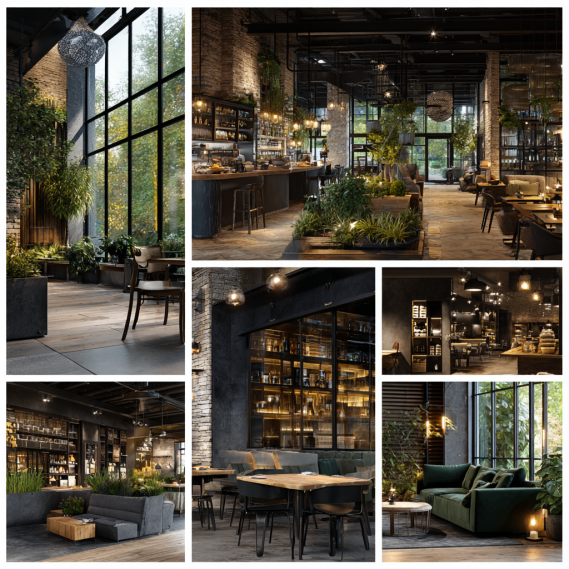
Hire Top Commercial Interior Designers in CA
Work with seasoned commercial interior designers who deliver clear timelines, Title 24-savvy lighting, and finishes that stand up to real use.
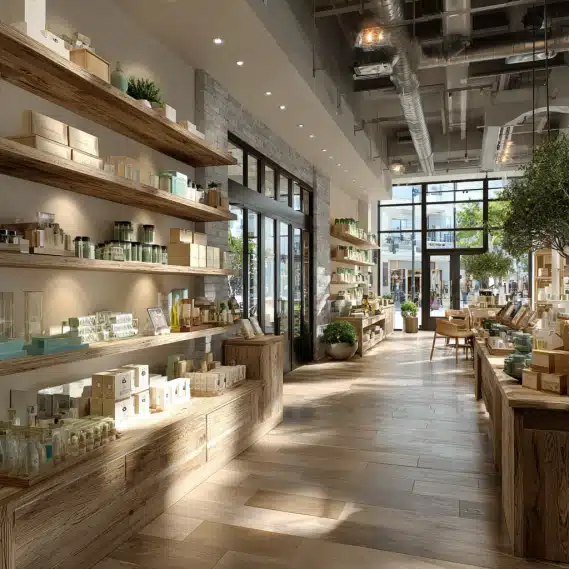
Retail Interior Design
Retail interior design plays a crucial role in attracting customers and influencing their shopping behavior. A well-designed store layout guides the customer’s journey and enhances their overall experience.
Popular Materials
- Polished concrete or ceramic tiles for modern, durable flooring.
- LED lighting to highlight products and create an inviting ambiance.
- Glass storefronts for maximum visibility and natural light.
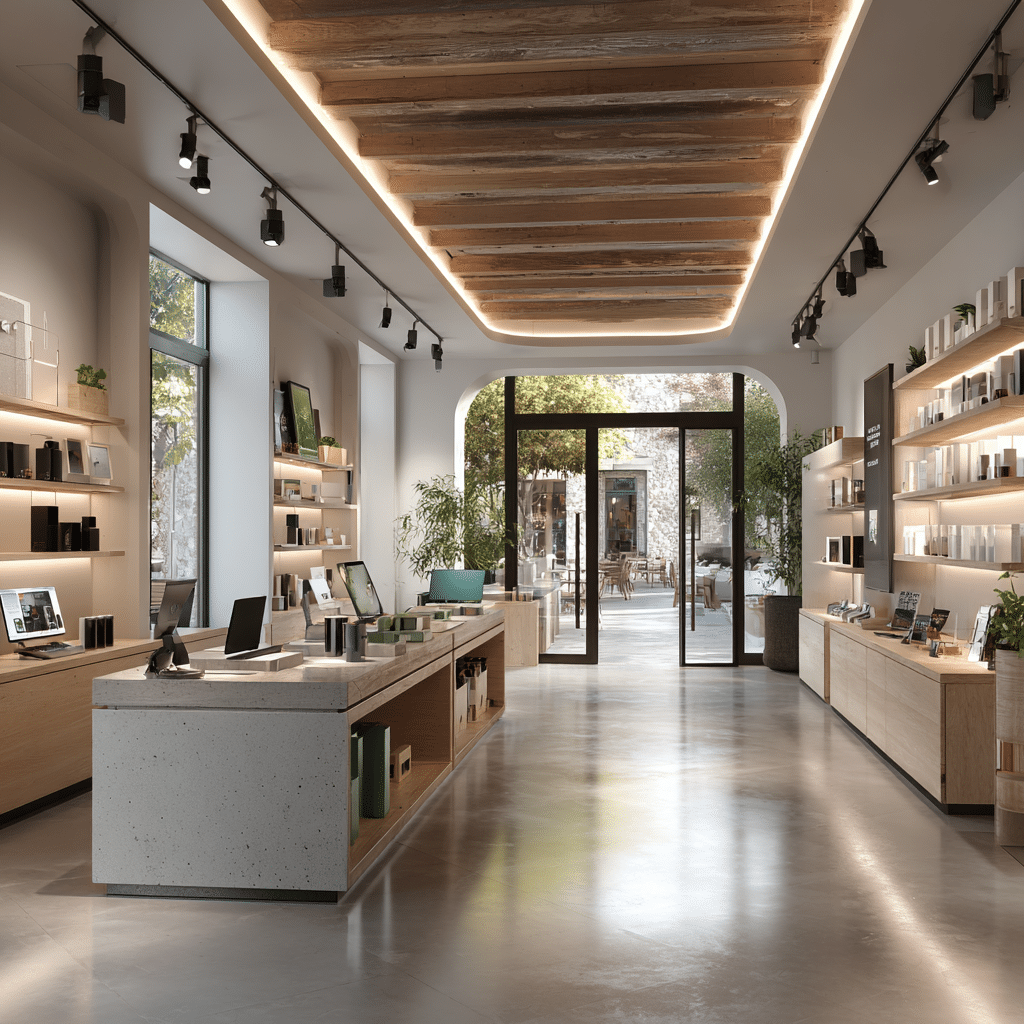
Key Design Elements:
- Clear navigation paths: Make it easy for customers to move through the store.
- Engaging window displays: Attract customers and draw them inside.
- Atmospheric lighting: Create an inviting atmosphere that aligns with the brand.
Popular Examples in California:
- Apple Store, Santa Monica: The store’s minimalist design with interactive displays enhances customer engagement.
- Nike Flagship Store, Los Angeles: Uses industrial design elements, like exposed brick and steel, paired with modern technology for a dynamic shopping experience.
Statistics:
- Retailers with well-designed interiors see up to 40% higher sales compared to those with generic layouts.
Hospitality Interior Design
Hospitality spaces like hotels, restaurants, and cafes need to create a memorable and comfortable experience for customers while also optimizing functionality for the business.
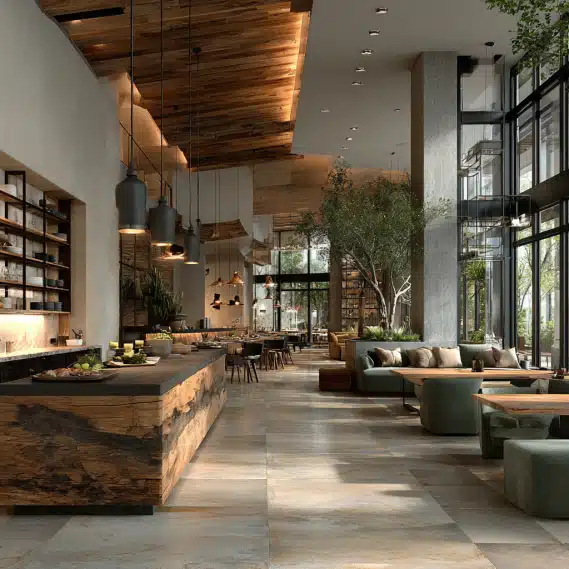
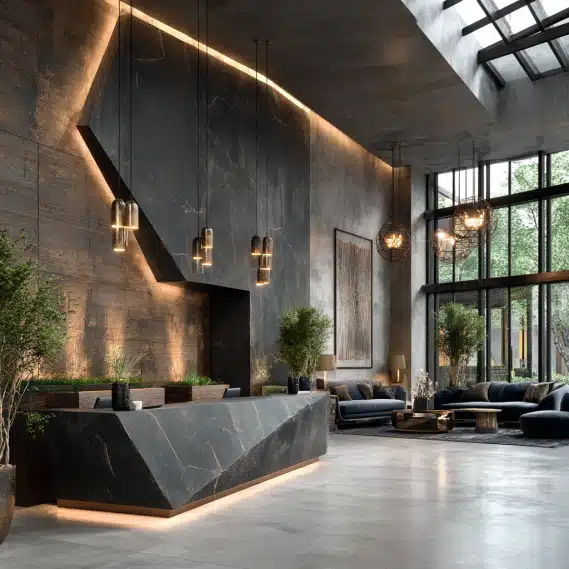
Popular Materials
- Velvet upholstery for a luxurious feel in hotels and lounges.
- Recycled wood and bamboo in eco-conscious designs.
- Brass accents for a touch of elegance in high-end restaurants.
Key Design Elements:
- Comfortable seating: Encourages relaxation in cafes and hotels.
- Ambient lighting: Creates an inviting atmosphere.
- Branding integration: Reflects the business’s identity throughout the space.
Popular Examples in California:
- The Ritz-Carlton, Los Angeles: Features opulent materials and a timeless design that emphasizes comfort and luxury.
- The Ace Hotel, Los Angeles: Blends industrial chic with relaxed, modern design elements, appealing to a younger demographic.
Statistics:
- 80% of hotel guests say that the interior design of a hotel impacts their overall experience.
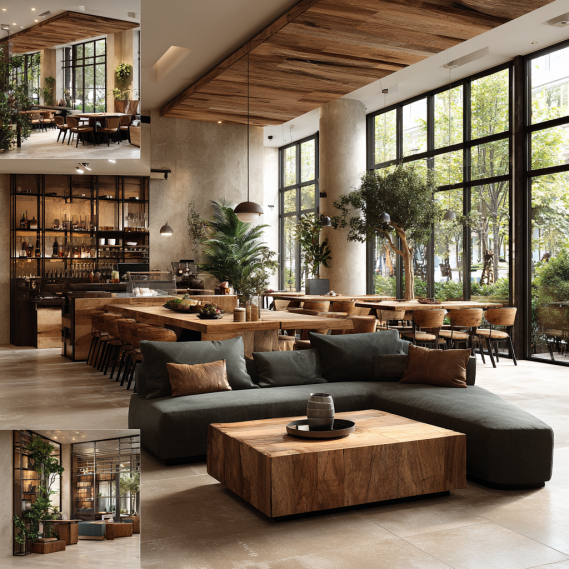
Trusted Commercial Interior Design Firms Statewide
Partner with one of California’s go-to commercial interior design firms for strategy, space planning, materials, and commissioning under one roof.
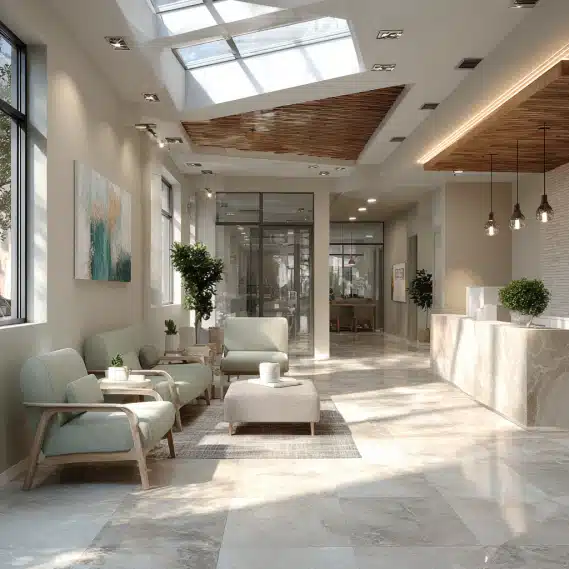
Healthcare Interior Design
Healthcare interior design is focused on creating environments that promote healing, comfort, and well-being for both patients and healthcare providers. A well-designed healthcare space is not only functional but also has a calming and supportive atmosphere, reducing patient anxiety and improving overall care. The layout and materials used in healthcare settings are crucial for creating a healing environment.
Popular Materials:
- Natural Elements: Materials like wood, stone, and bamboo are often used to create a serene and natural atmosphere. These elements reduce stress and promote a sense of calm. For instance, wood paneling or wooden floors add warmth to hospital rooms or waiting areas, making them feel less clinical and more inviting.
- Soft Fabrics and Upholstery: Upholstered furniture with soft, durable fabrics provides comfort to both patients and visitors. Vinyl or leather seating is common in waiting areas for easy maintenance, while softer fabrics are used in patient rooms to provide a homely feel.
- Anti-microbial Surfaces: In healthcare facilities, materials with anti-microbial properties like Stainless steel, ceramic tiles, and Quartz surfaces are commonly used for countertops, sinks, and flooring. These materials help reduce the spread of infections and ensure hygiene in high-touch areas.
- Low-VOC Paints and Finishes: Low-VOC (volatile organic compounds) paints and finishes are used to improve air quality and reduce exposure to harmful chemicals, crucial for the health of both patients and healthcare staff.
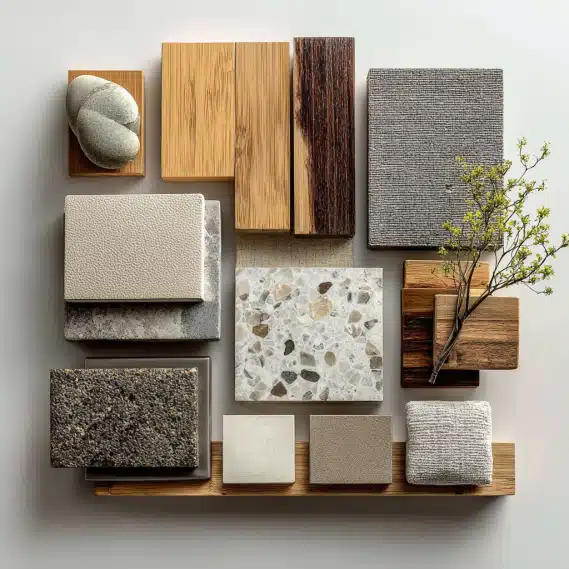
Key Design Elements:
- Healing Spaces: Patient rooms are designed to promote rest and relaxation. The inclusion of comfortable furniture, soothing color palettes, and natural light can have a positive effect on recovery times.
- Biophilic design elements such as plants, natural light, and natural textures are used to reduce stress and improve emotional well-being. Studies show that patients in rooms with access to natural views experience faster recovery.
- Wayfinding: Clear and easy-to-navigate spaces are essential in healthcare settings. Signage systems, color-coded areas, and intuitive layouts guide patients and visitors through facilities with minimal stress.
- Privacy and Comfort: Privacy is a key consideration, particularly in patient rooms. Soundproofing, private spaces for consultations, and room layouts designed for comfort all help ensure that patients feel secure and respected.
- Efficiency for Healthcare Workers: The layout must support medical staff by minimizing the time spent moving between spaces. Well-designed nurses’ stations, storage solutions, and clear paths ensure efficient workflows and provide staff with the tools they need to care for patients effectively.
Popular Examples in California:
- Kaiser Permanente (Oakland, CA): Known for its biophilic design, this healthcare facility integrates natural elements such as large windows for natural light and living green walls. The design aims to promote well-being not only for patients but also for staff.
- Cedars-Sinai Medical Center (Los Angeles, CA): Features soft lighting and warm tones in waiting areas, along with artwork and materials that create a calming atmosphere. The facility uses materials like wood paneling and natural stone to reduce stress for patients and visitors.
Statistics:
- Healing Environments: According to the Center for Health Design, patients in hospitals with access to natural light recover 20% faster than those in spaces without natural views.
- Employee Well-being: Research from Haworth reveals that healthcare staff working in environments with thoughtful design experience 15% less stress compared to those in poorly designed spaces.
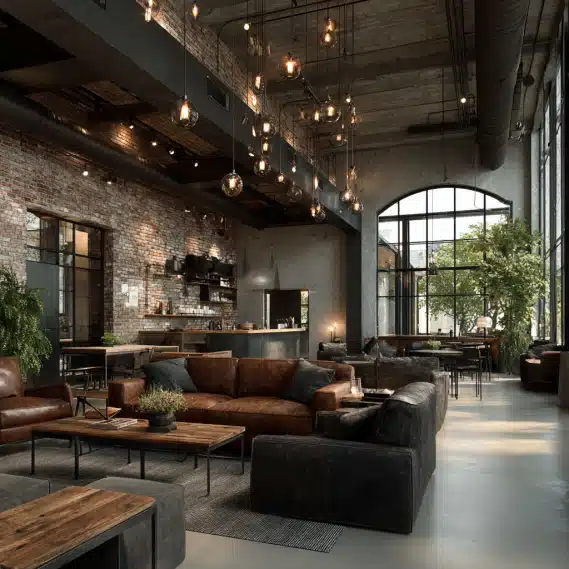
Industrial Interior Design
Industrial interior design embraces raw materials and an unfinished look, offering a bold and modern aesthetic. This style is often seen in offices, cafes, and urban retail spaces.
Popular Materials:
- Exposed brick and steel beams for an industrial feel.
- Concrete floors for a modern, durable design.
- Reclaimed wood for a sustainable touch.
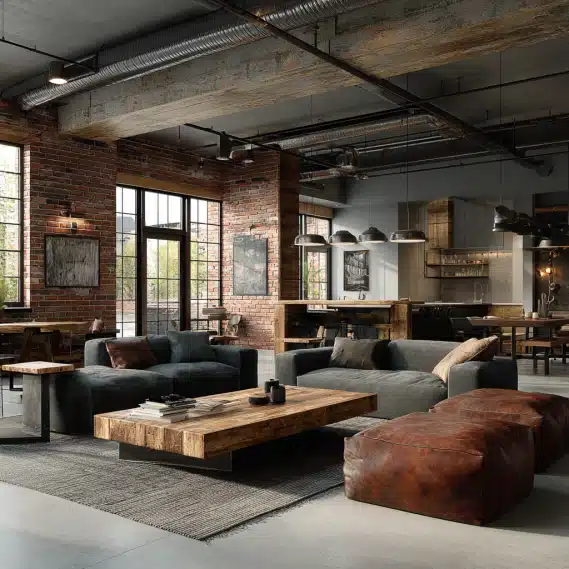
Key Design Elements:
- Exposed structures: Show off the building’s bones for a rugged look.
- Minimalist design: Focus on functionality while maintaining an aesthetically pleasing look.
- Urban touches: Incorporate elements like metal, glass, and wood for an industrial vibe.
Popular Examples in California:
- The Factory, San Francisco: A co-working space that blends industrial elements with modern design for an innovative work environment.
- In-N-Out Burger locations: Utilize industrial design elements to promote efficiency and simplicity.
Statistics:
- 45% of people find industrial interior design more appealing due to its authenticity and raw appeal.
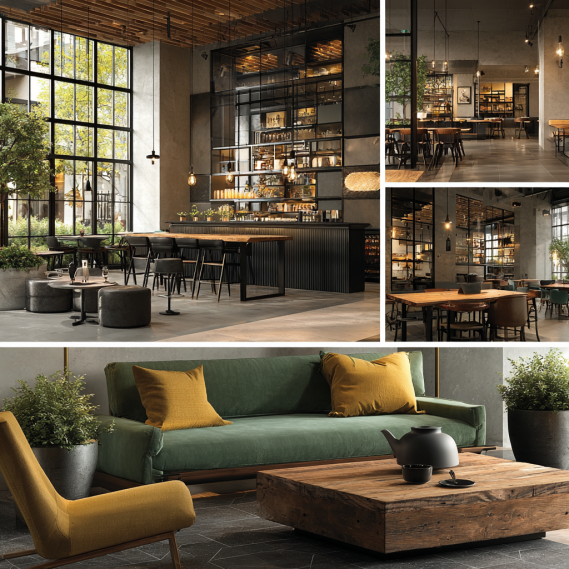
Find Commercial Interior Design Near Me (CA)
Serving Los Angeles, Orange County, San Diego, Bay Area & beyond: fast, local, and compliance-ready commercial interior design near me.
How Is Commercial Design Different from Residential?
Designing a home and designing a business space both involve floor plans, finishes, and furniture, but the similarities end fast. Commercial projects operate under stricter codes, heavier usage, more stakeholders, brand requirements, and measurable business outcomes. Residential projects prioritize personal lifestyle, comfort, and taste, with looser constraints and one primary decision-maker.
Why the Type of Commercial Interior Design Matters
Choosing the right type of interior design for your commercial space can make a big difference. Not only does it impact the functionality and flow of your business, but it also has the power to influence customer perceptions and employee satisfaction.
- For retail businesses, design can affect sales by creating an atmosphere that encourages customers to linger and make purchases.
- In office environments, a well-designed space can boost employee morale and productivity, while a poorly designed one may lead to dissatisfaction and disengagement.
- In hospitality, design directly impacts the experience of guests, affecting whether they return or recommend the business to others.
Current Trends in Commercial Interior Design
As we move forward, the trends in commercial interior design are shifting towards sustainability, flexibility, and technology integration.
Biophilic Design: Incorporating natural elements like plants and green walls is becoming increasingly popular in both office and retail spaces.
Sustainability: Many businesses are opting for eco-friendly materials like bamboo, reclaimed wood, and energy-efficient lighting.
Technology: Interactive displays, smart lighting systems, and automated climate control are becoming standard in modern designs.
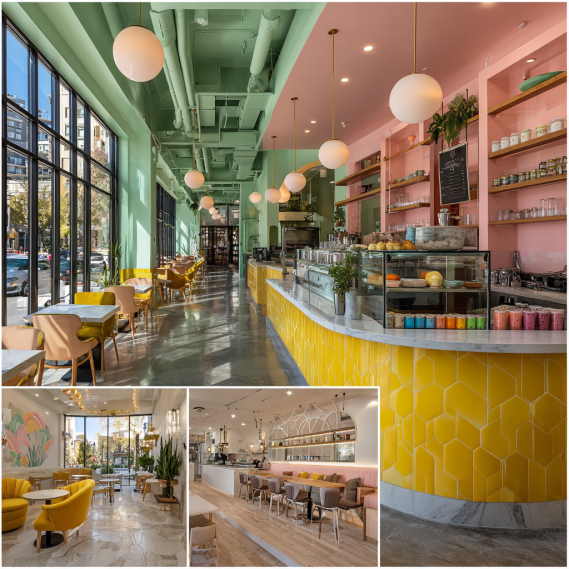
Office Space Interior Design That Boosts Productivity
Balance focus rooms, collaboration hubs, and brand cues with high-CRI lighting and acoustic control: expert office space interior design for CA teams.
Why Is Commercial Interior Design Important for Business?
Smart commercial interior design isn’t just about aesthetics, it’s a business lever. In California, where energy codes, green standards, and customer expectations are high, interior design for commercial spaces directly shapes revenue, operating costs, compliance, employee performance, and brand perception.
- Daylight drives sales. California retail studies (Heschong Mahone Group) found skylit stores were associated with higher sales, with one chain’s modeling showing up to +40% if skylights were adopted chain-wide; a second study across 73 CA stores confirmed a significant daylight–sales link (smaller magnitude, still positive).
- Workplace design boosts performance. Large workplace surveys show employees are most productive in offices that support multiple work modes (focus + collaboration + social), reinforcing the ROI of thoughtful office layouts, lighting, and acoustics. (Gensler Global Workplace Surveys 2024–2025).
- Lower operating costs via Title 24. California’s Energy Code (Title 24) requires occupancy/vacancy shut-off, time-switch, partial-off, and daylight-responsive dimming in nonresidential spaces—cutting lighting run-time and utility bills when properly commissioned.
- Compliance + fewer change orders. CALGreen nonresidential mandatory measures (low-VOC materials, C&D waste reduction, IEQ basics) are standard in CA—baking them into specs early avoids redesigns and inspection delays.
- Experience = revenue. SFO’s award-winning Harvey Milk Terminal 1 improvements (daylight, amenities, wayfinding) exemplify how better interiors elevate passenger experience and support concession performance; SFO won ACI-NA “Best New Passenger Experience” for the HMT1 lounge.
Conclusion
Commercial interior design is a dynamic and essential aspect of any business. The right design not only creates a visually appealing space but also enhances functionality, employee satisfaction, and customer experience. Whether you’re designing an office, a retail store, or a restaurant, understanding the different types of commercial interior design will help you create a space that suits your business needs and supports long-term success.
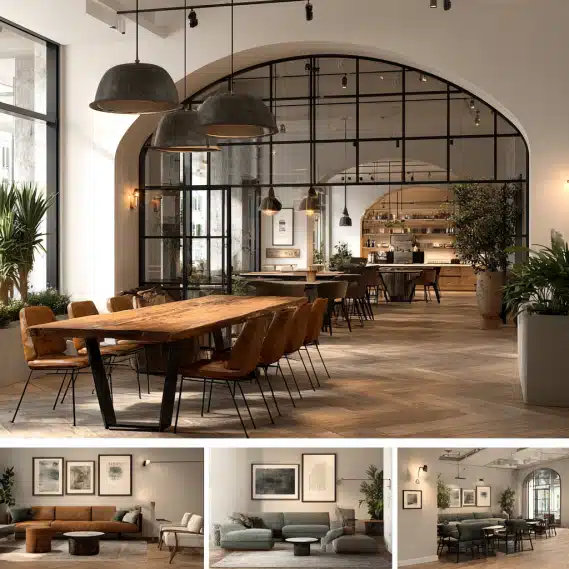
Commercial Building Interior Design, Done Right
Lobby to restroom to tenant suites: cohesive commercial building interior design that raises asset value and lease appeal.





